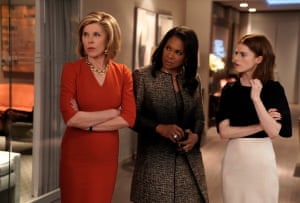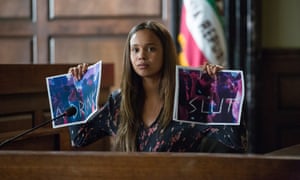In the new season of GLOW, we watch as Ruth, played by Alison Brie, prepares to go to a dinner meeting with the head of the TV station her show is featured on. His secretary tells her he loves the work she is doing on the series. We see her excitement as she approaches the restaurant where she is set to have dinner, her reaction to the slight red flag that she will be meeting him in his private room, and her relief when she sees a familiar face greet her at the door. Later, we see her panic when that familiar face leaves and she is forced to come to terms with the reality of the situation.
Throughout these difficult scenes, the camera is focused on Ruth and her myriad emotions: her initial excitement at being recognized for her work, her sad realization of what is actually occurring, her disbelief, terror, resignation and determination to get out of this unfair situation as intact as possible. It is a scene that is effective precisely because it doesn’t titillate or scandalize the viewer, but instead illustrates how the threat of assault is sickeningly ordinary.
It’s the emphasis on centering the survivor’s experience that ultimately marks today’s look at sexual harassment onscreen, and what differentiates it from past depictions, where the effects of harassment were often minimized. Take a 1994 episode of The Simpsons called Homer Badman for example, where poor, innocent Homer is thrown to the media wolves after being falsely accused of groping a feminist babysitter, when, in reality, he was just reaching for candy that got stuck to her bottom. In one scene, a group of grad students confront Homer with signs that say things like, “You Pinch, We Lynch!” In another, a random woman being interviewed on TV is barely able to get through her interview because she is crying:
“I don’t know Homer Simpson, I’ve never met Homer Simpson, or had any contact with Homer Simpson,” the woman says, as she collapses into tears “… I’m sorry, I can’t go on.”
“That’s okay,” the talk show host says, “Your tears say more than real evidence ever could.”
While the episode does a great job interrogating a media culture that is obsessed with ratings over the truth, Homer Badman also paints a portrait of sexual harassment complaints as a dangerous witch hunt against innocent men, led by a bunch of overly political young people, and a media that is obsessed with salacious news.
If you go to the YouTube comment sections of any of the clips of this episode, you see a number of people rallying around Homer and dismissing feminist concerns about harassment as basically overblown. I still wonder about the ways that the media I watched growing up shaped my perception of male and female interactions.
In Animaniacs (a show for children!) Yakko and Wakko would chase after a buxom and terrified Hello Nurse for comedic effect, and in shows like 30 Rock, a sexy intern being routinely ogled by much older men was meant to be a hilarious joke. The idea that harassment is annoying, but ultimately harmless, or just something that attractive women have to put up with (that it’s actually a compliment, rather than a problem) is still a relatively mainstream idea.

Today, there are many shows working to change that culture, not only by illustrating the pernicious effects of harassment, but also by delving deeply into the challenges of dismantling a system that is so tacitly accepted in our society. In this season of GLOW, for example, we not only focus on Ruth’s perspective during the harassment scene, but we also see how different people respond when she conveys her story, with some characters being supportive, while others are surprisingly indifferent, or even cruel.
Likewise, in the most recent season of The Good Fight, a show that never shies away from looking at topical issues with depth and nuance, one of the plotlines involves a journalist telling her former professor that his obsession with another woman in class who he was interested in dating came at the expense of her own professional development. Another episode looks at today’s complex generational feminist debates about harassment culture, when a younger woman running an “Assholes to Avoid” website, loosely based on the Shitty Media Men list, challenges Diane’s skepticism about its utility and dismisses her as being part of an older wave that is now washed up.
In this way, not only do shows like these demonstrate just how common harassment is, they also emphasize the diversity of feminist responses. In Jessica Jones, for example, we see how survivors of sexual harassment and assault respond to the men who hurt them in different ways, some constructive, and others less so.
In other shows, like Dietland, the focus is more directly on women’s anger, as we see a group of female vigilantes who torture and kill abusive men, many of whom are in the beauty and fashion industries. In some cases, like in Unbreakable Kimmy Schmidt and Cameron Esposito’s recent stand-up special, “Rape Jokes” we see how humor and compassion can be effective tools for talking about these issues.
In Unbreakable Kimmy Schmidt, this is done by focusing on a gender-swapped harassment scenario in which Kimmy inadvertently ends up with a complaint against her after trying to be “friendly” with a male co-worker she is instructed to fire. In “Rape Jokes” Esposito approaches her difficult subject matter with humor, warmth and wisdom, and, at the end of her set, quite literally gives a shout-out to the male members of the audience, telling them directly that they can help to change this culture.
The message that survivors matter and that we have the power to push back against abuse is echoed in a lot of media targeted at younger audiences too. In the second season of 13 Reasons Why, for example, we see women of all ages, races, orientations and backgrounds take the stand and share ways in which they too have been the victims of sexual violence.

Often, critics talk about the timeliness of these shows, but the shift towards more compassionate and nuanced portrayals of survivors has actually been going on for a while now. Since 2013, Orange is the New Black has been looking at how female prisoners are impacted by rape culture, from guards that ogle inmates, to ones that outright rape and abuse the people they are charged with supervising. Likewise, Jill Soloway’s Transparent includes a plot line that looks at the way that Josh’s abuse by an older babysitter is downplayed by many members of his own family.
Perhaps what is actually changing the most is how viewers talk about these shows. Throughout the time that Mad Men was airing, we saw female characters endure any number of sexually coercive, inappropriate situations, from the way that new secretaries were gawked at by men in the office, to business meetings being held at strip clubs, to innumerable cases of outright assault and rape. At the time the series ran, there were often discussions online about whether or not Don’s aggressively threatening Bobbi Barrett by grabbing her hair and digitally penetrating her counted as an assault, or if it was merely rough foreplay. Likewise, some viewers questioned whether Joan was “really raped” by her fiancé. Others wondered whether Don’s first time really counted as rape, even though the show clearly shows a woman assaulting a child.
What #MeToo has provided viewers is not merely the opportunity to center survivor stories, but also the vocabulary to interrogate a culture that perceives sexual harassment and assault as basically normal. This doesn’t mean that we should revisit older media and “cancel” it because it doesn’t fit into newly evolved sensibilities, but it does mean we have the responsibility as viewers to consider how our interpretation of behaviors is often shaped by social mores that can be as subtle as they are insidious.
Perhaps one way that we can ensure that #MeToo is not just a moment but instead a movement is for viewers to pay attention to the ways that their engagement with the nuanced media that tackles these issues is part of what is necessary for things to tangibly change.